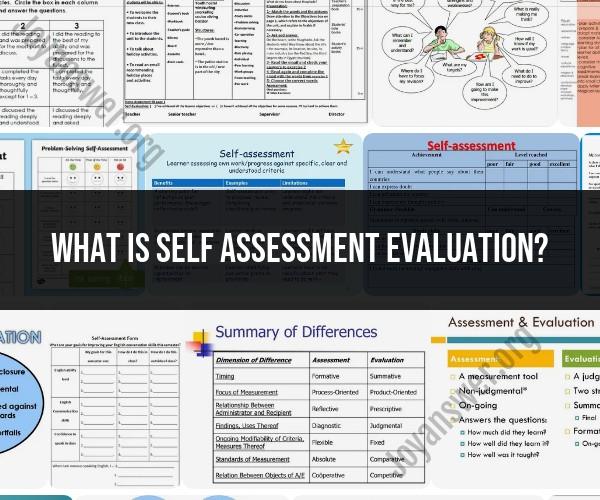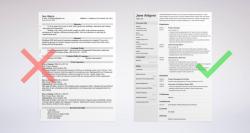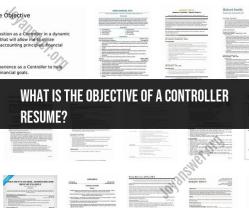What is self assessment evaluation?
Self-assessment evaluation, also known as a self-appraisal or self-review, is a process in which an individual assesses and evaluates their own performance, skills, accomplishments, strengths, weaknesses, and areas for improvement within the context of their job or role. It is commonly used as part of the performance appraisal or performance management process in organizations. Here's a breakdown of what self-assessment evaluation entails:
Self-Reflection: It involves taking time to reflect on one's own performance and contributions. Individuals think about their accomplishments, tasks completed, challenges faced, and the progress they've made over a specific period, often aligning with the organization's performance cycle.
Assessment Criteria: Self-assessment typically involves evaluating oneself against specific criteria, such as job goals, performance standards, key performance indicators (KPIs), competencies, and job responsibilities. These criteria are often outlined in the individual's job description or performance expectations.
Setting Objectives: In self-assessment, individuals may set personal objectives and goals for their professional development and job performance. These goals should be aligned with the organization's goals and mission.
Strengths and Achievements: Individuals highlight their strengths, accomplishments, and successes during the evaluation period. They may provide examples, metrics, or evidence to support their claims.
Areas for Improvement: Self-assessment also involves acknowledging areas where improvement is needed. Individuals should identify weaknesses, challenges faced, or skills they want to develop further.
Self-Rating: Self-assessment often includes assigning self-ratings or scores to various aspects of performance or competencies. These ratings can be on a numerical scale, such as 1 to 5, or descriptive (e.g., exceeds expectations, meets expectations, needs improvement).
Feedback and Self-Critique: Individuals provide a self-critique of their performance, offering insights into what they did well and where they fell short. They may discuss why they believe they achieved certain results or encountered specific challenges.
Goal Setting: As part of self-assessment, individuals may set future goals and action plans. These goals should address areas for improvement and align with the organization's objectives. Goals are often specific, measurable, achievable, relevant, and time-bound (SMART).
Alignment with Organizational Values: Self-assessment may include a reflection on how well an individual's behavior and actions align with the organization's values, culture, and mission.
Professional Growth: It offers individuals an opportunity to consider their professional growth and development, including any training, education, or skill-building activities they have undertaken or plan to pursue.
Performance Discussion: In many organizations, self-assessment serves as a starting point for a performance discussion or appraisal meeting with a supervisor or manager. During this meeting, the individual's self-assessment is discussed and compared with the manager's assessment.
Feedback and Goal Alignment: The self-assessment process often results in feedback and alignment of goals between the individual and their supervisor. It sets the stage for ongoing performance improvement, coaching, and development.
Self-assessment evaluation is valuable for both employees and organizations. It encourages self-awareness, accountability, and a proactive approach to personal and professional development. It also provides a foundation for constructive dialogue between employees and their supervisors regarding job performance, expectations, and growth opportunities.
Self-Assessment in Performance Reviews
Self-assessment is a valuable tool for performance reviews. It allows employees to reflect on their performance, identify areas for improvement, and set goals for the future. It also gives managers a better understanding of the employee's perspective and helps to inform the performance review process.
Here are some benefits of self-assessment in performance reviews:
- Improved performance: Self-assessment can help employees to identify areas where they can improve their performance. Once employees are aware of their areas for improvement, they can take steps to address them. This can lead to improved performance over time.
- Increased employee engagement: Self-assessment gives employees a voice in the performance review process. When employees feel like they have a say in their performance review, they are more likely to be engaged and motivated at work.
- Improved communication between managers and employees: Self-assessment can help to improve communication between managers and employees. The self-evaluation process can provide an opportunity for managers and employees to discuss the employee's performance and goals. This can lead to a more open and honest relationship between managers and employees.
Steps for Conducting a Thorough Self-Evaluation at Work
To conduct a thorough self-evaluation at work, follow these steps:
- Review your job description and performance goals. This will help you to focus your self-evaluation on the most important aspects of your job.
- Gather feedback from others. Talk to your manager, colleagues, and customers to get their feedback on your performance. This feedback can help you to identify your strengths and weaknesses, as well as areas for improvement.
- Reflect on your performance. Think about your accomplishments, failures, and challenges over the past performance review period. What went well? What could have gone better? What did you learn?
- Set goals for the future. What do you want to achieve in your next performance review period? Set specific, measurable, achievable, relevant, and time-bound goals.
- Write your self-evaluation. Be specific and provide evidence to support your claims. Be honest and objective, and focus on your performance, not your personality.
Using Self-Evaluations to Showcase Skills and Growth
Your self-evaluation is an opportunity to showcase your skills and growth to your manager. Here are some tips:
- Be specific and quantify your accomplishments whenever possible. For example, instead of saying "increased sales," say "increased sales by 15%."
- Use strong action verbs to describe your accomplishments. For example, instead of saying "responsible for developing a new marketing campaign," say "developed a new marketing campaign that resulted in a 20% increase in website traffic."
- Focus on your results and the impact your work had on your team and the company. For example, instead of saying "managed a team of 10 employees," say "managed a team of 10 employees and achieved a 95% customer satisfaction rating."
- Highlight your skills and growth. Think about the new skills you have learned and the ways you have grown in your role over the past performance review period. Use your self-evaluation to highlight these skills and growth.
By following these tips, you can use your self-evaluation to showcase your skills and growth to your manager and improve your chances of getting a positive performance review.












